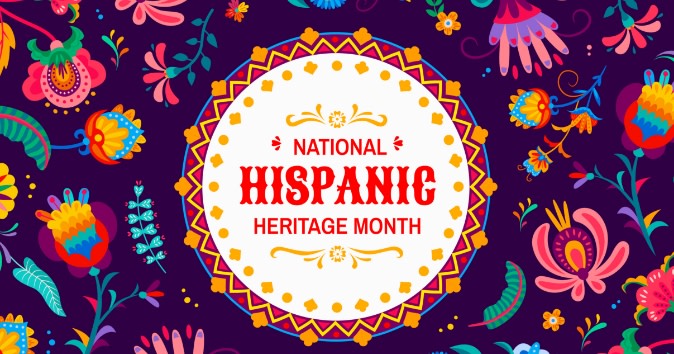How to Celebrate Hispanic Heritage Month at Work
It’s Hispanic Heritage Month! Observed from September 15 to October 15 annually, Hispanic Heritage Month is a time to reflect on the indelible impact the Hispanic and Latiné community has left on American society.
You may be wondering how to celebrate Hispanic Heritage Month at work in meaningful and impactful ways. After all, it’s important to remember how to carry the spirit of learning and inclusion throughout the year.

Before we dive into our list of activities to consider within your workplace, let’s start with some basics about the day itself.
- In what year did Hispanic Heritage Month begin?
- Hispanic Heritage Month begins on September 15 because it coincides with the independence days of which five countries?
- What is celebrated during Hispanic Heritage Month?
- What is the theme of Hispanic Heritage Month?
Whether you know the answers to the above questions or you’re educating yourself for the first time, keep in mind that the more you know, the better you’ll be able to foster an inclusive workplace environment:
- Hispanic Heritage Month began in 1968 as Hispanic Heritage Week under President Lyndon Johnson and was expanded by President Ronald Reagan in 1988.
- Not only does the 15th of September coverOpens in a new tab the independence days of Costa Rica, El Salvador, Guatemala, Honduras, and Nicaragua, but Mexico, Chile, and Belize celebrate their own independence days within the subsequent week, and the national day of Spain, the Fiesta Nacional de España, falls on October 12.
- Hispanic Heritage Month celebratesOpens in a new tab the countless contributions of more than 60 million Hispanic Americans, Latinos, Latinas, and Latiné and Latinx-identifying people to our culture and society.
- The theme of Hispanic Heritage Month in 2023 is “Latinos: Driving Prosperity, Power, and Progress in America.”
If you have more questions about National Hispanic Heritage Month, you can find useful insights in the article “Four Questions About National Hispanic Heritage Month,Opens in a new tab” published by education.com.
Now that we’ve explored a little trivia about Hispanic Heritage Month, let’s take a deeper dive into the rich history of this cultural celebration and how you can thread it throughout your workplace to foster even greater diversity and inclusion.
What is Hispanic Heritage Month?
Hispanic Heritage Month is a month-long celebrationOpens in a new tab of the histories, cultures, and contributions of Americans whose ancestors came from Spain, Mexico, the Caribbean, and Central and South America. Ever since it extended from a week to a month-long celebration in 1988, it has been observed nationwide through festivals, art shows, conferences, community gatherings, and more.
Although Hispanic Heritage Month officially includes the term “Hispanic,” it’s important to remember that this term is not all-encompassing, and that language has evolved to become more inclusive through the years. Currently, the pan-ethnic terms “Latinx” and “Latiné” are seen as the most inclusiveOpens in a new tab, but let’s review the distinctions between terms.
- “Hispanic” refers to a person with ancestry from a country whose primary language is Spanish. However, the term is problematic to many, as it centers around the heritage of the colonial powers responsible for the slaughter of Latin America’s 56 million Indigenous people during the largest genocide in history.
- “Latino” (as well as the feminine “Latina”) refers to a person with origins from anywhere in Latin America (Mexico, South, and Central America) and the Caribbean. These terms, however, due to their masculine and feminine forms, do not encompass all genders and can be perceived as non-inclusive.
- “Latiné” refers to a people from Latin America and can be used when referring to a group of people of multiple genders or for a person identifying as nonbinary, gender fluid, genderqueer, bigender, agender, or gender nonconforming.
- “Latinx,” similarly, is a gender-neutral term and inclusive of all genders – it’s commonly used among English speakers in the U.S., as opposed to Latiné, which is what’s commonly used among Spanish speakers.
The point is that these terms cannot be used interchangeably. While the celebration is called “Hispanic Heritage Month,” it’s important to understand the nuance between terms, why the difference between them matters, and how they have evolved over time.
Why is celebrating Hispanic Heritage Month at work important?
Hispanic Heritage Month provides the opportunity to raise awareness about the influence and contributions of Hispanic, Latino, Latina, and Latiné and Latinx-identifying people across the United States. It provides insight into Hispanic and Latiné culture and traditions, which helps to break down barriers, overcome stereotypes, and develop a broader understanding of the cultural history.
In the workplace, celebrating Hispanic Heritage Month offers the opportunity to recognize and celebrate Hispanic and Latiné achievements, fostering employee engagement, strengthening connections across teams, and raising awareness around the importance of diversity and inclusion.
In recent years, attention to diversity, equity, and inclusionOpens in a new tab (DEI) has grown at companies across industries and geographies. An estimated $15.4 billion is to be spent on DEI-related initiatives by 2026, according to the Global Parity AllianceOpens in a new tab, an action-oriented, cross-industry group committed to advancing DEI globally, within organizations and across the corporate ecosystem.
But progress has been slow – even slower in recent years due to the pandemic. In the past five years, only one in three companies has made progress in executive-team diversity, while shrinking job opportunities have disproportionately affected minorities.
All of this is to say that celebrating cultural milestones like Hispanic Heritage Month, Black History Month, Women's History Month, Pride Month, Juneteenth events and many others are an excellent way for your organization to demonstrate that your values of inclusion and diversity are worth being celebrated.
So, with that, let’s dive into our curated list of Hispanic Heritage Month activities and games to consider in 2025 (and beyond).
How to celebrate Hispanic Heritage Month at work
Host a Hispanic Heritage Month trivia competition
Trivia is one of our favorite ways to celebrate Hispanic Heritage Month at work because it offers the opportunity to learn something new in a fun, interactive, and engaging format.
You can go the route we did with trivia about the history of Hispanic Heritage Month, or you can bring in modern-day trivia questions about Latin American singers, artists, actors, authors, musicians, politicians, and activists.
The key is to learn together, connect, and be challenged.
Support Employee Resource Groups
Chances are more than likely that, if you’re hosting Hispanic Heritage Month trivia (or any other activity throughout the month, for that matter), it’s organized and facilitated by one of your company’s Employee Resource Groups (ERGs).
ERGs are voluntary, employee-led groups that work to foster a diverse, inclusive workplace aligned with an organization’s values. These groups exist to provide support and help members in personal or career development as well as to create a safe space where employees can share experiences and build connections. Allies may also be invited to join ERGs to support their colleagues.
Whether you’re new to your organization or an existing team member, look for opportunities to get involved in ERG activities. Getting involved may mean participating in events or volunteer opportunities, asking questions, and keeping an open mind, telling leaders and other colleagues about the value of ERG work – or simply showing up to learn more.
Listening is often one of the best ways to show support – and this is true during Hispanic Heritage Month as well as at any other point throughout the year.
Offer Spanish language lessons
According to the U.S. Census BureauOpens in a new tab, Spanish is the most common non-English language spoken in U.S. homes. In fact, the proportion of the U.S. population that speaks Spanish grew from 5% to 13% from 1980 to 2015, making it the fastest-growing language across the U.S.
With those statistics in mind, what better way to celebrate Hispanic Heritage Month at work than to offer Spanish language lessons to your staff? This could be organized by an ERG or by bringing in a Spanish language instructor. You could also encourage employees to access free language learning apps like DuolingoOpens in a new tab, BabbelOpens in a new tab, or MemriseOpens in a new tab (many of which have leaderboards) and spark a little friendly competition!
At Workhuman, members of our DEI ERG have begun organizing a Slack channel, available companywide, for speaking and practicing Spanish. Although the idea originated during Hispanic Heritage Month, the group will be offering a monthly “cafecito Zoom” to continue the learning – and fun – throughout the year.
Organize a cooking class
The phrase “food is the key to a person’s heart” comes to mind with this Hispanic Heritage Month activity. The benefit to organizing a cooking class is three-fold: 1) Teams get to bond over the hands-on process of making a Latin American meal (and maybe even learn about ingredients and recipes they’ve never tried), 2) They get to celebrate Latin cuisineOpens in a new tab for its richness, both in culture and flavor, and 3) They get to eat a delicious meal!

This doesn’t need to be an expensive or extravagant activity, like bringing in a chef or visiting a test kitchen – you can organize a day in the office where a volunteer employee shares a beloved dish or demonstrates a family recipe. It can even be done virtually (depending on the size of your organization) by shipping ingredients to each employee’s house and jumping on a Zoom with a volunteer chef to guide employees through the process of making the meal.
Speaking of virtual, it’s important to remember that celebrating Hispanic Heritage Month at work should be inclusive of everyone – and that includes on-site, hybrid, and remote employees.
Let’s explore a few ideas:
How to celebrate Hispanic Heritage Month in a virtual environment
Offer a virtual tour
While you may not be able to fly down and climb Machu Picchu (we can dream!), the next best thing to offer your employees during Hispanic Heritage Month is a virtual tour of a museum, national park, landmark, or cultural site. These can be self-guided – most museums, such as the National Museum of the American LatinoOpens in a new tab or the Museum of Latin American ArtOpens in a new tab, offer free virtual tours that allow you to explore the museum’s galleries at your own pace – or they can be organized through an organization that offers professional virtual tour-guides.
During Hispanic Heritage Month, Unexpected Virtual Tours & TrainingOpens in a new tab took Workhuman employees on the “Experiencia Hispana y Latina Virtual Tour,” educating us on the importance of Hispanic and Latiné culture throughout history and into the present day. The virtual tour went from St. Augustine, FL to Austin, TX, and from the mid-1500s to today and included insights about the Taino, Tejano, and other cultures that are foundational to the mosaic of our society.
But it wasn’t all history – tour guides led the group through several rounds of “name that instrument” and asked all participants to name one influential person from Latin American descent they’d want to meet today, making for a fun, interactive, and engaging session.
Host a virtual book club
Reading the works of Hispanic and Latiné authors is another way to engage employees during Hispanic Heritage Month. Virtual book club meetings can help shine a spotlight on the voices within the Hispanic and Latiné community and can foster meaningful, lively discussions between participants.
Sharing, reading, and promoting literary works by Hispanic and Latiné authors in general is key. The more diversity in someone’s reading, the broader their perspective becomes.
Some of our favorite works include:
- The House on Mango Street by Sandra Cisneros
- Drown by Junot Díaz
- Paula by Isabel Allende
- How the Garcia Girls Lost Their Accents by Julia Alvarez
- Like Water for Chocolate by Laura Esquivel
There are so many influential works to choose from, you may find the book club you organized during Hispanic Heritage Month is one you’ll want to continue with throughout the year.

Frequently Asked Questions
Is it Hispanic Heritage Month or Latinx Heritage Month?
While the month is officially referred to as “Hispanic Heritage Month,” currently, the pan-ethnic terms “Latinx” and “Latiné” are seen as the most inclusive.
What colors represent Hispanic Heritage Month?
The colors that represent the month are vibrant colors like orange, red, yellow, and green, which reflect the spirit of joy found throughout many Latin American countries.
What is the most important thing about Hispanic Heritage Month?
Hispanic Heritage Month is meant to not only honor Hispanic and Latiné culture and heritage but also to shine a light on how far there is to go in representation across every level of American society. In that sense, the month serves as a moment to refocus on the issues confronting the community and reenergize for advocacy in the remaining months of the year.
See for yourself how Workhuman’s Social Recognition® solution — with its Inclusion Advisor feature — can help you remove unconscious bias and foster DEI in the workplace.
Closing thoughts
Celebrating Hispanic Heritage Month involves raising awareness about the deep impact of Hispanic and Latiné culture throughout history – and this includes taking the time to observe the month in the workplace. But it’s important to remember that promoting inclusivity doesn’t begin and end with any heritage month – it’s something that should be promoted throughout the year.
So, ask yourself: What did you learn about how to celebrate Hispanic Heritage Month at work and how can you carry that spirit of inclusion forward?
About the author
Stacy Thompson
Stacy Thompson is senior director of content strategy & activation at Workhuman. A lover of language, Stacy focuses on bringing company stories to life from ideation to execution. A Midwestern native, Stacy lives in Billerica, MA with her husband, two kids, and two cats – and spends her time outside of work running, skiing, writing, reading, and yoga-ing.